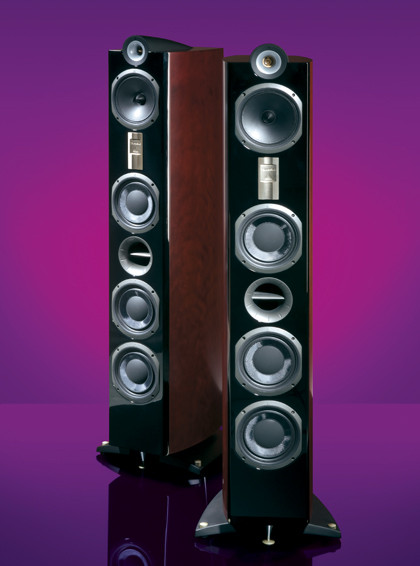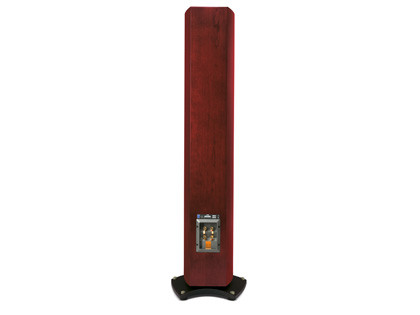TechRadar Verdict
Pros
- +
Fine overall balance
- +
Dynamic midband
- +
Top class imaging
Cons
- -
Bass lacks some precision, grip and a measure of authority
Why you can trust TechRadar
Founded some thirty years ago in North East France and one of three major French speaker brands to make a serious impression on the international stage, Triangle's success is primarily due to its very distinctive drive unit technology.
The £3,300 per pair Lyrr is the largest of three stereo pairs in the Genese range, which itself occupies the middle ground between the inexpensive Esprit EX series and the seriously upmarket Magellan range.
Both the smaller Genese models, the Quartet floorstander and the Trio standmount, have been reviewed previously in Hi-Fi Choice, with, it must be said, somewhat mixed results. While both had distinctive and attractive characteristics, both also had their fair share of weaknesses, too.
Drumskin behaviour
The common ground between the three Genese models is unmistakable. All share the half external horn-loaded tweeter on the top and the curved veneered enclosure sides.
In truth and since both are floorstanding three-ways, the Lyrr is much closer to the Quartet, with similar pleated surround midrange drive units and steel plinth arrangements.
The Lyrr's three-way driver line-up has three 160mm bass units with 120mm fibreglass/carbon fibre cones and high-excursion rubber roll surrounds. This impressive-looking collection is mounted with one above and two below a twin 'Siamesed' port arrangement and takes up much of the front panel.
The large moulded twin port, divided by a central horizontal divide, is presumably arranged to load the driver above and the two below separately, reflecting an internal divide that creates two distinct sub-enclosures.

Above the multi-driver bass section and positioned unusually high off the ground, is one of Triangle's unconventional midrange drivers. This also has a 160mm-diameter cast alloy frame, but in this case it is fitted with a plain 133mm-diameter paper cone and a short-travel pleated surround.
The point is that a driver that only covers midrange frequencies doesn't require cone excursion – the cone actually behaves a little like a drumskin and the surround's job is merely to absorb the vibrations that get to the edge of the cone and avoid re-radiating them. (There are obvious parallels with the FST driver Bowers and Wilkins uses in most of its three-way models.)
Above that midrange driver and actually well above seated ear height, the Lyrr's tweeter is a horn-loaded 25mm titanium dome, mounted in a pod that's half in and half out of the enclosure proper.
Although the mounting arrangements would seem to promote wide dispersion, in fact this is likely to be cancelled out by the relatively narrow distribution created by the horn.
Massive spikes
The whole thing sits on a proper steel plinth, which comes fitted with rubber feet and a front-centre 'grounding' pointed cone with captive disc, all of which ensures polished floors won't suffer damage.
A set of four massive spikes for carpet penetration is also supplied, though these lack lock-nuts and the disc on the front cone cannot be removed. Stability is good – the plinth essentially supporting the speaker as a tripod with two extra stabilisers.
The tall floorstanding enclosure is elegantly finished in mahogany stained real wood veneer, with a piano gloss black front. (All over piano black is also available at an extra £350). Curved sides give extra strength and superior internal standing wave and reflection control, while internal partitions and braces further stiffen the structure. Neat magnetic grilles attach to screw heads holding the drive units and two pairs of high-quality socket/binders act as input terminals.
The previously mentioned price tag is quite hefty and, perhaps, sits a little uncomfortably between the mainstream and the high end, but you do get a whole lot of speaker for your money here, with a considerable selection of high class ingredients.
Unusual height
The Lyrrs were fed primarily from a system comprising a Naim NAC552 preamp and NAP500 power amplifier (driven from Naim CDS3/555PS and Rega Valve Isis CD players) and a Magnum Dynalab MD106T FM tuner. Vinyl record players included a Linn/Rega hybrid and a Funk modified Linn with FXR II, both using a Soundsmith Strain Gauge cartridge.
Positioned well clear of walls, as common sense indicated and subsequent measurements confirmed, first impressions are very positive, thanks to the loudspeaker's fine overall neutrality across a wide bandwidth.
The bass goes satisfyingly deep, while staying free from unwanted mid-bass emphasis and thickening; the midband is well projected and dynamically involving, if not entirely free from some 'paper cone' colorations, while the treble is well integrated and free from fierceness or edginess.
Perhaps the Lyrr's most distinctive characteristic is its unusual height, which somehow aids the precision of the stereo image. Exactly why this should be the case we cannot say for sure.
Perhaps it's due to a combination of the midrange driver delivering the sound from a little above the listeners and slightly reducing the impact of floor reflections. Or, perhaps, it's due to the relatively directional nature of the horn tweeter and the consequent reduction in room-reflected top end. But, there is no disputing the evidence of the ears, or the general superiority of the Lyrr's imaging.

While the bass is certainly well balanced and extended, it could have rather more authority and grip. It fills in the bottom end very effectively, but doesn't exactly impose itself on the music.
First and foremost one notices the midrange and while the bottom end doesn't in any way lag behind in timing terms, it doesn't seem to drive the music along with any particular purpose or intent.
The midband is a trifle exposed and not exactly free from colorations, but it is wonderfully communicative through the voice band, delivering fine expression and the full intentionality of singers and speech. Furthermore, this is achieved without sounding either 'shut in' or unpleasantly aggressive – in other words, the presence band and the mid-to-treble transition is very well judged indeed.
And while there is some slight 'quack' and occasional edginess, one quickly adjusts to this little bit of 'character' and the presentation always retains its fine timing and dynamic expression.
First class
The Lyrr is far from inexpensive, yet it ticks an awful lot of boxes. Though physically far from discreet, it's good looking in a 'tall dark and handsome' way and fashionably slim to boot.
It's a sonically very attractive prospect, too. The Lyrr supplies a fine neutral balance with deep and even bass, a dynamic and well-projected midband and a well-integrated top end.
It's not the last word in bass authority perhaps, but its stereo imaging is first class.
Follow TechRadar Reviews on Twitter: http://twitter.com/techradarreview
